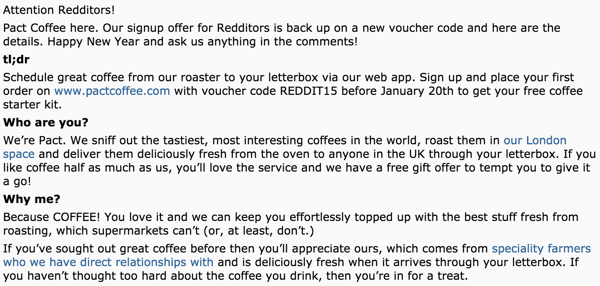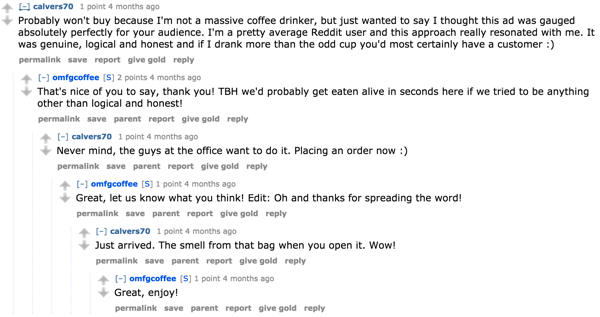The blog that follows consists of a series of short posts that support my arguments.
One link is not a chain.
Last week I was at Youth Marketing Strategies 2015 and saw a presentation from a business called Social Chain, given by the 22 year old Steve Bartlett. I mention his age because this was repeatedly emphasised, given their promise of access to the elusive ‘youth market’ with a ‘reach’ of a claimed 128,302,222 followers. The reaction of many in the audience was positive, given the popularity of the narrative of the young entrepreneur. However, as experienced marketers when something looks too good to be true it behooves further investigation.
Social Chain claim to be ‘the UK’s largest influencer marketing agency’, offering pseudo-organic reach. Rather than paying Facebook, Twitter, et al. you pay Social Chain to broadcast to followers of a claimed 2,000 ‘communities and influential individuals’ so in theory they can offer some broad targeting by topic. This is a somewhat blunt instrument as without access to the data that allows for more precise targeting that only the platform itself allows all that is happening is a broadcast to followers of a particular account, only some of whom will see the message. A business model based on someone else’s platform and no proprietary technology is inherently flimsy as you possess no greater insight than anyone else.
While their main website mentions they manage Facebook Pages the reduction in organic reach means this platform is effectively closed to them, a point raised during Steve’s presentation. One of their founders mentions they created trends such as ‘Students Don’t Say’. A quick search for this term reveals a plethora of pages, the largest of which has around 60,000 followers. Of the multiplicity of theses Pages on this theme that may or may not belong to the Social Chain none have been updated for over a year. This abandonment is likely due to the fact that posts no longer reach enough followers without paying Facebook for the privilege, highlighting the weakness inherent in so-called ‘influencer marketing’.
This pattern of a large number of similar pages appearing around a theme has been duplicated on Twitter. Using Followerwonk it’s simple to track down a selection of accounts Social Chain operate, e.g. ‘Hogwart’s Logic’, ‘Student Problems’, etc. Some of these accounts have large follower counts. ‘Nickelodean Reaction’ has 77,490 followers but has only tweeted 16 times despite being 425 days old. Which is interesting. Does it seem likely that an account that has tweeted so few times would reasonably attract so many followers? Has it been repurposed from something else and old tweets removed? Either way, there are questions to be answered here.
The most popular account identified by Followerwonk is Common White Girl with over 700,000 followers, although this account no longer identifies as being part of Social Chain in its bio. Recently it’s been pushing a Snapchat-alike app called Fling.
This is produced by another young entrepreneur’s business that Steve Bartlett ‘advises’. This is the same business that tried to launch a Facebook-alike social network called ‘Unii’ some months ago and is listed as a Social Chain client. Given these are not identified as adverts I would expect these tweets are a breach of ASA guidelines. Again, this is something a questioner challenged Steve on during his presentation which he largely brushed off.
A review of the favourites of this account are mostly items Steve mentioned as things Social Chain promotes. Without labouring the point I’m fairly sure if we connected all of the various accounts Social Chain operate we’d find a similar pattern of behaviour, including these accounts retweeting one another.
Ultimately I don’t see the marketing value here. Even if you wanted your brand to be associated with one of these accounts, which in my opinion comes with a reputational risk, I’d want to know how many of these followers are shared by multiple Social Chain operated profiles. Looking across the accounts identified by Followerwonk the general level of sharing is quite low, which limits the performance of an advertising message that appears as a non-sequitur in these streams. Perhaps they do have over 2,000 accounts; given these will be publicly accessible the capable marketer shopuld be able to construct a list by following patterns of tweets and retweets from known nodes in their network. Given the fundamental rules of how complex networks operate any genuine super-spreaders should become apparent.
The marketing material I’ve been sent by Social Chain highlights how they create trending topics, ephemeral hashtags usually thrown up by user activity and identified by Twitter’s algorithms. During YMS they started a ‘trend’: #FictionalDeathsI’llNeverGetOver. They cite 15,832 users tweeting 16,010 times with 15,658 retweets. I interpret this as meaning that the original number of tweets with this hashtag was quite small and these were then simply retweeted. If this is the case then what’s interesting is how small a number of people it takes to achieve a trending topic in the UK. This isn’t marketing however, it’s simply gaming how Twitter identifies a trending topic. There is no guarantee as to how many followers of those retweeting this saw those tweets, nor an indication of secondary spreading where someone not already following one of these broadcasting accounts chooses to pass the message on.
A more interesting perspective would be if Social Chain linked to what must be the publicly accessible work they say they have carried out for bebo, The Economist, Haribo, Microsoft, etc. as this is far more indicative of the effect they can achieve.
Besides Facebook and Twitter it’s possible Instagram offers some opportunity. However, as the platform deliberately restricts linking from images the marketing potential is commensurately reduced, as is the value of any service offering to post for money. Given that the business model of each platform is the monetisation of largely proprietary data held about their users, Social Chain is in fact a competitor to the platform they rely upon, hence their business model is extremely vulnerable.
The final part of Steve’s presentation saw him mentioning how Social Chain were now managing vloggers and even the accounts of minor celebrities. Acting as agents for or as social media managers to individuals is different to what I’ve discussed so far, however the direct management of accounts is likewise likely to come under further scrutiny by the ASA, as is payment for a mention not identified as such. Regardless, follower counts and ‘views’ are not an accurate measure of marketing value.
Ultimately Social Chain isn’t marketing to young people. It’s marketing to marketers. In the words of Bob Hoffman:
“There’s no bigger sucker than a gullible marketer convinced they’re missing a trend.”
Update: I’ve reinstated this post as of March 2016. I took it down a few months ago after Steve Bartlett of the Social Chain got in touch with me on Twitter and claimed it contained inaccuracies. I asked him to send me corrections and offered him a right-of-reply and promptly forgot all about it. Seeing as he not only failed to get back in touch but then deleted those tweets I can only assume there is nothing in dispute.
Let me know what you think on Twitter
There is no way these huge companies can provide the same intimate level of customer service that I can, especially since I don’t have that many customers.
This article epitomises why I don’t ‘get’ Yahoo.
Jerry Shen, who developed a fantasy sports app, cites the fact he responds immediately to customer enquiries as what differentiates him in the marketplace. That’s how he wins recommendations.
“Large competitors like Yahoo and the NFL soon launched their own mobile fantasy sports apps, and Shen tried to think of ways he could differentiate his product. His solution: charm customers with great customer service, responding to any complaints within five minutes.”
Yahoo has likely paid a lot of money to accquire his business. Jerry’s apps are gone.
“He became a director of engineering at the tech giant, managing a team….”
Hell of an expensive way to recruit someone. Perhaps Jerry is much more talented than anyone else at creating these fantasy sports games so this will give Yahoo competitive advantage. But that isn’t how the article portrays Jerry’s success. It doesn’t sound like Jerry will be doing customer service or that facet is part of Yahoo’s plan.
Let me know what you think on Twitter
Native advertising done well.

Few implementations of the form get it right. Here’s one, which also appears on a platform where if you get it wrong, there will be consequences.
Pact Coffee first advertised on reddit last year. They attracted 1,247 comments and there are a number of really good interactions between redditors and Pact’s account omfgcoffee.
They ran a second advert more recently which caused a few problems as new customers were being offered a very nice Hario V60 dripper – existing customers were a little aggrieved. Pact handled it well.
Their follow-up about their experience was a clever move; r/selfserve is the subreddit for people who want to advertise on reddit so sharing this is in the spirit of the community.
With the New Year they are back for more; I signed-up recently myself.
Clearly there are dimninishing returns in terms of interactions with other redditors but it would be interesting to know the amount of business this generated.
Responses like this are gold:

What I like about the most recent advert is how well it suits the platform. This medium suits Pact far better than a banner advert or a piece of advertorial ever would.
- It’s longform (for an ad)
- In the right tone of voice
- The offer is clear and direct
- They say who they are and what they do
- They focus on the benefits of their service
A nice touch is they reference the comments on their first very successful post.
Ultimately omfgcoffee is a redditor who is promoting what they do rather than Pact appearing as a brand using reddit for advertising. And that is the note you want to hit without lookng like you’re trying to hit it.
Let me know what you think on Twitter
The whole article I’ve taken the above quote from is great.
“BuzzFeed is a tech company. One which is wholly focused on aggregrating a mass audience. It has no other value beyond that.”
I’d disagree that Buzzfeed have a mass ‘audience’ however. They have massive ‘traffic’ in the ephemeral sense of visitors coming and going but I wonder if this is an audience in the sense of people deliberately choosing Buzzfeed as a source of entertainment rather than just a place they end up on from a shared link.
Buzzfeed’s visitors will be distributed on a very long tail so the usefulness to marketers to get their messages to people is minimal. However, it suits Buzzfeed that the industry thinks otherwise. Their content machine is a very hungry beast that needs constant feeding; if marketers pay to help it grow then this is to Buzzfeed’s advantage.
On ‘Vice’:
“Their entire effort is to literally get themselves a cable channel. They’ve played an interesting game: They created a brand. They’re not a tech company. They’re a real, traditional media company.”
Again, I wonder if this is sustainable? They’ll have to keep the cost of producing original stories in check while the complexity of what they are doing increases.
Let me know what you think on Twitter

